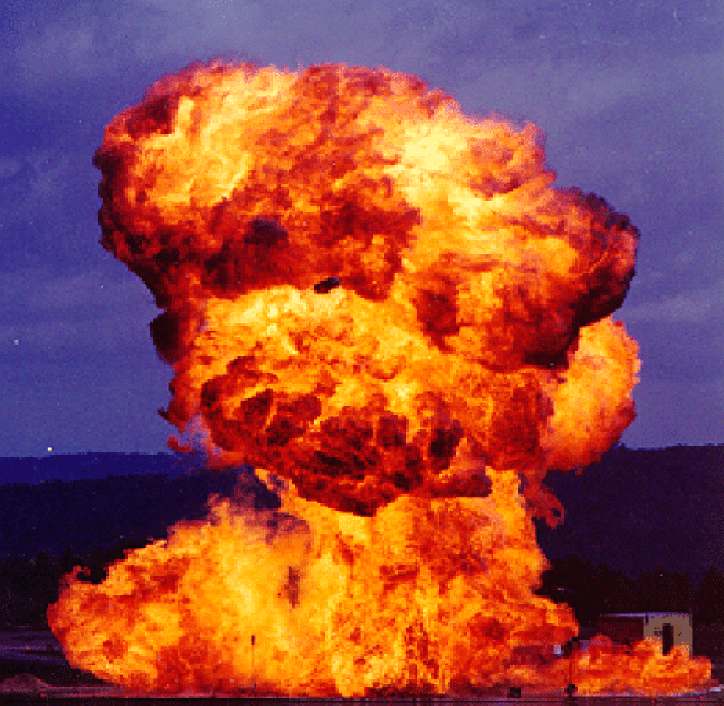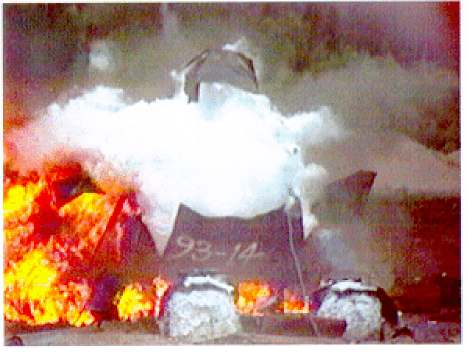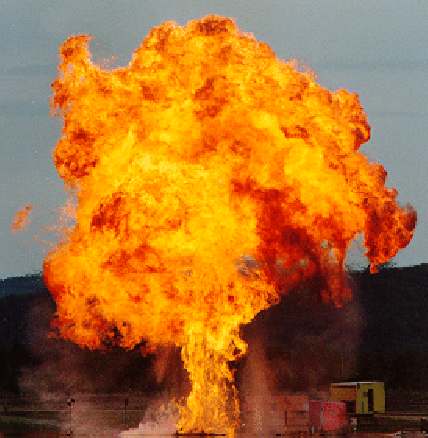BLEVE Incident Simulator for Windows
Simulation Software for LPG and Propane BLEVE Incidents.
from ThermDyne Technologies Ltd.

From the same technical expertise that brought you the training video "BLEVE Response and Prevention". This software is intended as a BLEVE incident training tool, scenario analyzer and response planner.
The BIS software was developed with the help of Professor A. M. Birk PhD. P.Eng. of Queen's University, a leading expert on BLEVEs and their consequences. The program is based on his research activities since 1981, and research from other leading organizations.
Who Should Have it.

FireFighters, Emergency Responders and Training Officers
If you are lucky, you may never be called to a BLEVE incident. But if you are, you need to know what to expect and why. This simulation software is intended as a basic training simulator for responding to BLEVE incidents. It will help keep you fresh on the topic in case you ever have to deal with a BLEVE in your area.
Emergency Response Planners
This software will help you get ready for that unlikely event. You can estimate hazards and plan response tactics. You can study likely fire scenarios and plan evacuation procedures.
Plant Engineers and Managers
Where ever there are LPG or similar liquefied gas tanks, the BIS can assist in planning and design. With the BIS hazard estimates the plant designer can fine tune plant layout. They can study various accident scenarios and use this information to assist in the planning for minimal damage.
How to use it.
Go out and look around in your area for potential BLEVE situations. Look for propane or LPG loading and unloading areas for trucks and rail cars. Look for storage tanks for industrial, rural or urban uses. Make note of the tank sizes, and distances to nearby structures or inhabited areas. Look for confined areas where gases can collect. Now go back to your office and use the BLEVE Incident Simulator to conduct what-if analysis.
Step by Step Input.
The software asks the questions that you, as a responder, should be asking. These include:
- is life or property at stake ?
- what was the time to respond ?
- how long has the fire been burning ?
- how big is the tank?
- is the tank thermally protected?
- what is the fire contact type and severity ?
- what are the wind conditions ?
- what is the ground topography ?
- are there other tanks or hazards?
- are there confining structures ?
BLEVE Hazards Prediction.
With this information the program goes to work to estimate the hazards including:
- BLEVE blast
- BLEVE fireball
- projectiles and tub rockets
- Vapour cloud explosions (VCE)
From this the user is given critical advice on:
- responder command position
- fireball damage vs distance
- blast damage vs distance
- expected projectile ranges
- possible VCE blast vs distance
- recommended evacuation distances
- effects of wind
- cooling water flow rates
- cooling water supply
Tank Thermal Model.
If you responded to a LPG or propane tank fire incident, you would want to know things like, how long it should take the fire to empty the tank through the pressure relief valve, or how big the fireball would be if the tank failed. You would like to have some idea of the likelihood that the tank will fail and when.
The tank thermal model is a detailed computer simulation of a pressure vessel in a fire. This computer model accounts for the following processes:
- fire heat transfer to the tank by thermal radiation and convection
- heat transfer by conduction through the tank wall and any thermal insulating layers
- heat transfer by convection and thermal radiation to the tank liquid and vapour contents
- thermodynamic heating and pressure buildup
- pressure relief valve action and mass flow
- tank wall stress buildup and tank strength changes due to elevated wall temperatures
- tank failure prediction
The user can run the tank thermal model to get an estimate of how the tank will respond to various types of fire exposure. The software analyzes engulfing or partly engulfing pool fires, remote pool fires and even torch fires. The input for the thermal model has been simplified and streamlined.
The software estimates critical times such as time to tank failure or time to empty for a tank under fire exposure. With the tank thermal model you see how the tank changes over time when it is exposed to fire, including:
- tank internal pressure
- liquid fill level
- wall temperatures
- tank stress and strength
With the tank thermal model it is possible to get an estimate for the time frames involved with different fire conditions, tank scales, fire types and thermal protection. You will develop a better understanding of how a tank responds to fire exposure.
Information Modules

All through the program the user can ask for more information on topics like:
- pressure tank design features
- fire exposure and tank weakening
- properties of pressure liquefied gases
- thermal protection or pressure tanks
- pressure relief devices
- tank failure mechanics
- blast sources and effects
- projectile types and range considerations
- fireball thermal radiation
- vapour cloud explosions
and others ....
Computer Needs
You will need a computer running Windows XP.
Windows XP is a Trademark of Microsoft Corporation. BLEVE Incident Simulator Copyright 1997-2011, ThermDyne Technologies Ltd. All rights reserved. Made in Canada.
